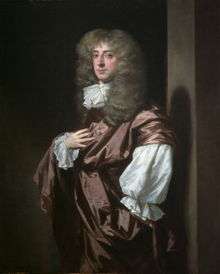Henry Thynne (1675–1708)


Henry Thynne (8 February 1674/75 – 20 December 1708) was an English gentleman and Tory Member of Parliament.
Thynne was the eldest of the three sons of Thomas Thynne, 1st Viscount Weymouth (1640–1714), of Longleat, a substantial landowner in Wiltshire and Gloucestershire, by his marriage to Lady Frances Finch, a daughter of Heneage Finch, 3rd Earl of Winchilsea.[1] He was christened on 16 February 1674/75 at Drayton Bassett.[2][3]
Thynne was educated at home and was very interested in literature. In 1692 he visited the Netherlands, Germany, and Italy.[1] As a young man, he taught French and Italian to his contemporary Elizabeth Singer (1674–1737), in whom Bishop Thomas Ken, then living at Longleat, had taken an interest when she was twelve.[4] In To the Painter of an Ill-Drawn Picture of Cleone, the Honorable Mrs Thynne, a poem by Anne Finch, Countess of Winchilsea, Thynne appears under the name of "Theanor",[5][6] while "Cleone" was his wife Grace, to whom Lady Winchilsea addressed several of her poems.[7]
At the election of 1695 Thynne stood unsuccessfully for parliament at Weobley.[1] He later sat as a Member of Parliament for Weymouth and Melcombe Regis in 1701, then briefly for Tamworth before representing Weymouth and Melcombe Regis again until his death in 1708.[1] At Tamworth, he was returned unopposed with Thomas Guy (1644–1724), the speculator and founder of Guy's Hospital.[8] Guy was a Whig,[9] while Thynne was a Tory.[1]
On 29 April 1695, Thynne married Grace Strode, the daughter and heiress of Sir George Strode and Grace FitzJames, who brought him a fortune of £20,000. They had two daughters, Frances Thynne, who married Algernon Seymour, 7th Duke of Somerset, and Mary Thynne (ca. 1702–1720), who married William Greville, 7th Baron Brooke (1695–1727).[3] His grandchildren included Elizabeth Percy, Duchess of Northumberland.[2]
Thynne became extremely fat. After he had died suddenly on 20 December 1708, the findings of a post mortem were reported in a letter to Edward Harley from his sister:
Though he never complained, his vitals were wholly corrupted, his heart was like a lump of fat and blood, when they touched his lungs they fell to pieces and had an imposthume in them which they think was the cause of his sudden death, his liver wasted, and an ulcer in his kidneys, and a dropsy in one side of his belly. I think this a strange mixture of distempers, but more unaccountable that he should not be sensible of any of them, but told his father and cousin at 12 o’clock the night before he died that he was as well as ever in his life, did not alter two minutes before his death, only said when he came downstairs his legs were weak, did not sit by his lady above six minutes before he died.[1]
On 3 January 1708/9 he was buried at Longbridge Deverill.[2]
Notes
- 1 2 3 4 5 6 "Thynne, Hon. Henry (1675-1708)". History of Parliament Trust. Retrieved 2011-11-24.
- 1 2 3 Henry Thynne at thepeerage.com, accessed 20 November 2011
- 1 2 Charles Mosley, ed., Burke's Peerage, Baronetage & Knightage (107th edition), vol. 1 (Burke's Peerage, 2003), p. 1291
- ↑ John Edward Jackson, 'The History of Longleat', in The Wiltshire archæological and natural history magazine, vol. 3 (1857), p. 306
- ↑ John Buxton, A Tradition of Poetry (London: Macmillan, 1967) p. 168
- ↑ Anne, Countess of Winchilsea, Poems (1903), of Anne Countess of Winchilsea 1903.djvu/561 p. 561 at Wikisource
- ↑ George Justice, Nathan Tinker, Women's writing and the circulation of ideas (2002) p. 168
- ↑ Sir Samuel Wilks, George Thomas Bettany, A biographical history of Guy's Hospital (1892), p. 24: "To the sixth Parliament of William, December 30th, 1701— July 2nd, 1702, Tamworth returned the Hon. Henry Thynne (only son of Lord Weymouth) and Thomas Guy. This was "a popular election and no opposition". "
- ↑ Collections for a history of Staffordshire (Staffordshire Record Society, 1920), p. 187: "Tamworth : Thomas Guy, Esq. (Whig)"